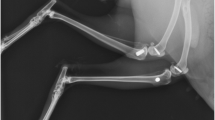Abstract.
Aim: The objective of the present experimental animal study was to investigate the stability of mini-implants (submersion depth 4 mm, Ø 3.3 mm) for orthodontic anchorage. Additionally the histomorphologic effects of orthodontic loading were to be analyzed, especially with regard to the activity and location of periimplant osteodynamic reactions.
Material and Method: 16 titanium implants (Orthosystem®, Straumann, Waldenburg, Switzerland) were inserted in edentulous areas of the upper and lower jaw of four foxhounds. After a 6-month healing period the fixtures were loaded with extrusive forces (50 cN) in group 1, and with translatory forces (200 cN) in group 2. The osteodynamic changes during the 6-month force application period were documented using stains with calcium affinity (polychrome sequential labeling). The histologic analysis comprised: microsection method, fluorescence microscopy, toluidine blue staining, histomorphometry.
Results: All osseointegrated implants were stable throughout the test period. With respect to the apposition lines, the histomorphometric analysis showed more distinct osteodynamic activity in extrusively loaded than in translatorily loaded implants. The activity was more pronounced in the marginal area than in intermediate and apical implant areas. The extent of peri-implant remodeling activity was up to 980 µm after extrusive loading and 300–700 µm after translatory loading.
Conclusions: The results suggest that even mini-implants are suited to orthodontic anchorage tasks. The question of the required minimum size of orthodontic anchorage implants remains unanswered.
Zusammenfassung.
Ziel: Ziel der vorliegenden tierexperimentellen Studie war es, die Stabilität von Miniimplantaten (Versenktiefe 4 mm, Ø 3,3 mm) für orthodontische Verankerungszwecke zu überprüfen. Gleichzeitig sollten die histomorphologischen Effekte einer orthodontischen Belastung, insbesondere im Hinblick auf Aktivität und Lokalisation der periimplantären osteodynamischen Reaktionen, analysiert werden.
Material und Methode: 16 Titanimplantate (Orthosystem®, Straumann, Waldenburg, Schweiz) wurden bei vier Foxhounds im Oberund Unterkiefer in zahnlose Kieferabschnitte inseriert. Nach einer Einheilungsphase von 6 Monaten wurden die Fixturen in Gruppe 1 mit extrusiven Kräften (50 cN) bzw. in Gruppe 2 mit Zugkräften (200 cN) belastet. Die osteodynamischen Veränderungen während der 6-monatigen Kraftapplikationsphase wurden durch calciumaffine Farbstoffe dokumentiert (polychrome Sequenzmarkierung). Die histologische Auswertung umfasste Trenndünnschlifftechnik, Fluoreszenzmikroskopie, Toluidinblaufärbung, Histomorphometrie.
Ergebnisse: Alle eingeheilten Implantate waren während der Testphase positionsstabil. Die histomorphometrische Analyse zeigte hinsichtlich der Appositionslinien bei den extrusiv belasteten eine stärkere osteodynamische Aktivität als bei den translatorisch belasteten Implantaten. Die Aktivität war im marginalen Bereich stärker ausgeprägt als in medialen und apikalen Implantatarealen. Die Ausdehnung der periimplantären Remodellierungsaktivität betrug nach extrusiver Belastung bis 980 µm, nach translatorischer Belastung 300–700 µm.
Schlussfolgerungen: Die Ergebnisse legen nahe, dass auch Miniimplantate für orthodontische Verankerungsaufgaben geeignet sind. Die Frage nach der erforderlichen Mindestgröße orthodontischer Verankerungsimplantate ist noch unbeantwortet.
Similar content being viewed by others
Author information
Authors and Affiliations
Corresponding author
Rights and permissions
About this article
Cite this article
Fritz, U., Diedrich, P., Kinzinger, G. et al. The Anchorage Quality of Mini-implants towards Translatory and Extrusive Forces. J Orofac Orthop 64, 293–304 (2003). https://doi.org/10.1007/s00056-003-0304-9
Received:
Accepted:
Issue Date:
DOI: https://doi.org/10.1007/s00056-003-0304-9




